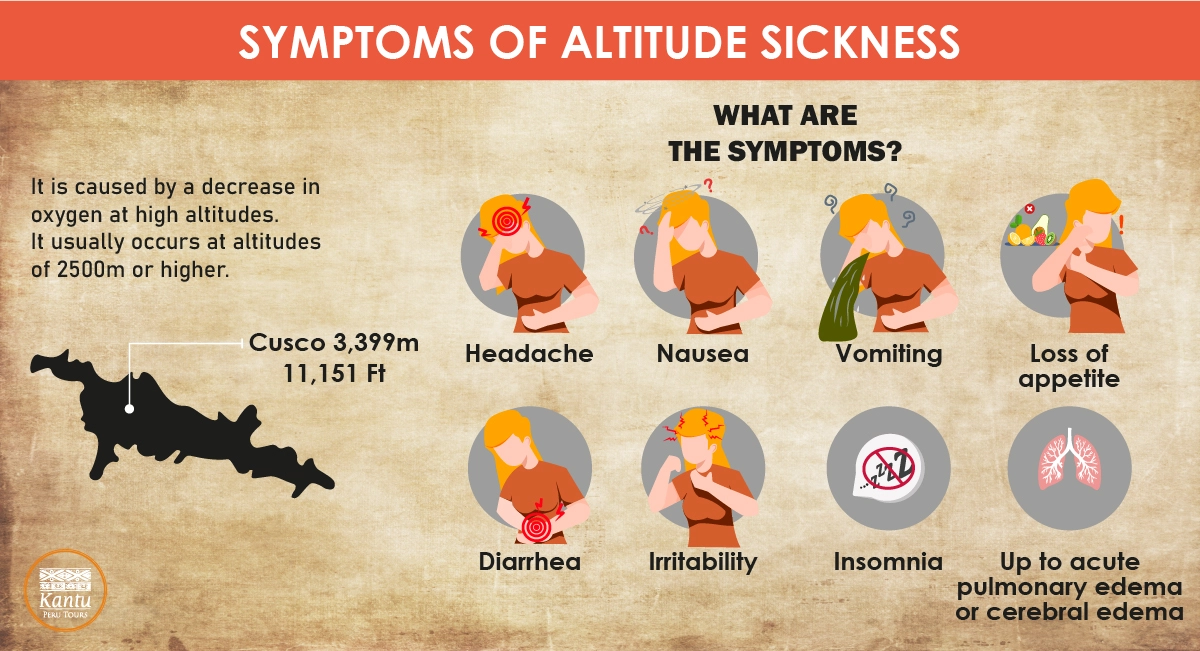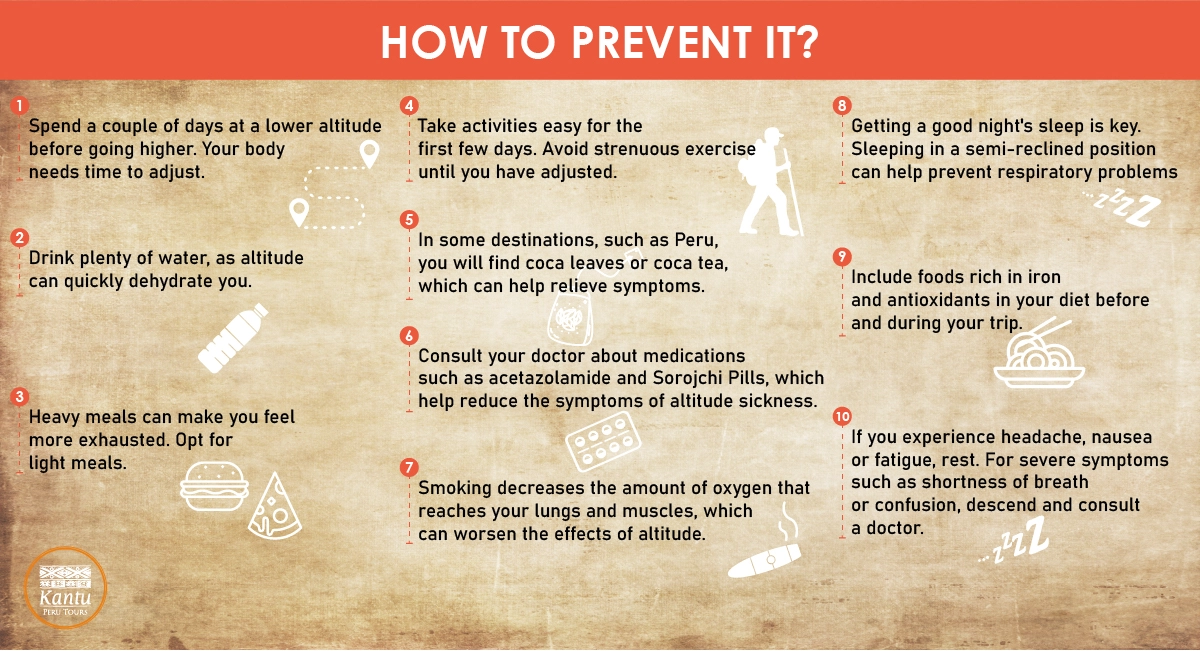Traveling to Cusco, renowned as the ancient Inca capital, is an incredible adventure, but its altitude of 3,399 meters (11,152 feet) can affect your well-being and put strain on your body. Altitude sickness is common in the region and can interfere with your experience if you’re not prepared. In this guide, Kantu Peru Tours will explain what Cusco altitude sickness is, how to identify its symptoms and complications, and what you can do to prevent or treat it. Get ready to enjoy Cusco without surprises, and remember: Cusco is a destination that requires more than just a desire to explore—it demands that your body adapt to the altitude!
Cusco Altitude Sickness: Why does it affect so many travelers?
Cusco Altitude sickness refers to any head pain caused by exposure to high altitudes. It is estimated that 80% of people experience some form of headache when exposed to altitudes above 3,000 meters (9,840 feet), a phenomenon known as Altitude Exposure Headache (AEH). This type of headache is included in the second version of the International Classification of Headache Disorders (ICHD-II).
On the other hand, altitude sickness (commonly known as soroche in Peru) is a collection of symptoms that occurs when the body fails to adapt quickly to the reduced oxygen levels found at high altitudes. At Cusco’s elevation of 3,400 meters (11,152 feet), the air contains 30% less oxygen, which can cause discomfort ranging from mild headaches to more serious issues, particularly during the first few days.

Symptoms of Cusco Altitude Sickness: Recognize them early
Cusco Altitude sickness symptoms can vary in intensity, but some are quite common, and it’s important to recognize them to act quickly. These include:
- Localized headache: A common first sign that your body is struggling with the altitude.
- Fatigue and Irritability: Despite feeling motivated to explore, you may feel unexpectedly exhausted.
- Insomnia: This affects 60% of people above 3,500 meters (11,480 feet), caused by periodic breathing and other factors such as headache and fatigue.
- Nausea and Dizziness: Another common symptom is stomach discomfort.
- Shortness of breath: Breathing may feel difficult even when at rest, as oxygen does not reach your lungs as easily.
- Swelling: Hands, feet, and face may swell, especially upon waking. It usually disappears after descending.
- Retinal hemorrhage: Bleeding in the retina from 2,700 meters (8,858 feet), most common at 5,000 meters (16,404 feet). It can cause temporary central vision loss if the macula is affected.
- Syncope: A temporary loss of consciousness caused by arrhythmias or hypoxia.
It’s important to keep in mind that everybody reacts differently, and in more severe cases, symptoms can intensify to include confusion and even coma.

Complications of Cusco Altitude Sickness
Cusco Altitude sickness can range from mild symptoms like headache (Altitude Headache) and nausea (Acute Mountain Sickness) to more severe conditions like Cerebral Edema (HACE) or Pulmonary Edema (HAPE), which affect the brain and lungs, respectively. Recognizing these symptoms early is essential to avoid severe complications while you stay in Cusco.
1. Altitude Exposure Headache (AEH): A common headache that occurs after exposure to altitudes above 2,500 meters (8,200 feet), caused by hypoxia (lack of oxygen) and increased intracranial pressure. Rest usually relieves it.
2. Acute Mountain Sickness (AMS): Common above 2,500 meters, causing headache or altitude headache along with nausea, fatigue, and dizziness. It improves with descent, medication, or within 24-48 hours.
3. High Altitude Cerebral Edema (HACE): A rare but serious encephalopathy affecting 0.5-1% of those with altitude sickness. It causes severe headaches, confusion, hallucinations, and difficulty walking. Urgent descent and medical attention are required.
4. High Altitude Pulmonary Edema (HAPE): Occurs after rapid ascents above 2,500 meters, causing coughing, difficulty breathing, and in severe cases, respiratory failure. Immediate descent is required.

How is Altitude Sickness diagnosed?
Altitude sickness is typically diagnosed clinically—based on symptoms. This means no blood tests or X-rays are needed; symptoms are observed, and the onset occurs between 6 to 24 hours after reaching a higher altitude.
The most widely used diagnostic tool is the Lake Louise AMS Scoring System, which helps assess symptom severity for early diagnosis and monitoring of symptoms. The diagnostic criteria take headache as a cardinal symptom in non-acclimatized individuals ascending rapidly above 2,500 meters, along with at least one of the following symptoms, each scoring 1 point:
-
- Gastrointestinal: Anorexia, nausea, or vomiting (1)
- Insomnia (1)
- Dizziness or vertigo (1)
- Fatigue (1)
A score of 3-5 indicates mild altitude sickness, while a score of 6 or more suggests severe altitude sickness, with signs such as disorientation, difficulty walking, cerebral or pulmonary edema, etc.

Which parts of the body are affected by Altitude Sickness?
Approximately 50% of people trekking above 5,000 meters (16,404 feet) experience headaches, one of the most common symptoms of altitude sickness. This occurs because the body does not receive enough oxygen at higher altitudes. However, other organs can also be affected, especially in severe cases:
1. The Brain: In severe cases, conditions like High Altitude Cerebral Edema (HACE) cause the brain to swell due to the lack of oxygen, leading to confusion, disorientation, and severe neurological symptoms.
2. The Lungs: In critical cases, High Altitude Pulmonary Edema (HAPE) can develop, causing fluid buildup in the lungs, making breathing difficult and potentially life-threatening.

Risk Factors: Who is most prone to Altitude Sickness?
A study of 506 mountaineers revealed that factors like a history of migraines, intense physical activity, and low oxygen saturation increase the risk of altitude headaches. Surprisingly, younger individuals were more affected, showing that good physical fitness doesn’t guarantee immunity from altitude sickness. Risk Cusco Altitude sickness factors include:
- Swift ascent: Ascending to high altitudes too quickly without allowing your body time to acclimatize is one of the main risk factors.
- Previous altitude illness: If you’ve suffered altitude sickness in the past, you’re more likely to experience it again.
- Living at sea level: People living below 900 meters (2,950 feet) are more prone to altitude sickness.
- Dehydration and excessive physical exertion: These can increase the risk.
- Diabetes, asthma, heart disease, or chronic obstructive pulmonary disease (COPD) don’t pose a higher risk of altitude sickness, but they can lead to complications.

Adventure at High Altitudes: The highest destinations in Cusco
Cusco is a complete destination known for its culture, but it’s also a favorite for hiking and adventure lovers. Before tackling the highest peaks, starting your exploration at lower altitude destinations is recommended to acclimate properly. Some great options for acclimatization include a City Tour of Cusco (3,399 m), Sacred Valley (3,400 m), Maras and Moray (3,500 m), or even visiting Machu Picchu (2,430 m).
These destinations will allow you to adjust to the altitude while enjoying the region’s history and culture, preparing your body for higher challenges. Once acclimatized, continue your adventure at the highest peaks for unique experiences and breathtaking views:
- Nevado Ausangate (6,384 m): A mystical journey through stunning landscapes and turquoise lagoons.
- Nevado Salkantay (6,271 m): Ideal for those seeking an extreme experience, surrounded by towering mountains and valleys.
- Vinicunca (Rainbow Mountain) (5,200 m): Famous for its colorful slopes, offering one of the most vibrant landscapes in the Andes.
- Palcoyo (4,900 m): A less crowded alternative, equally spectacular with unique rock formations and panoramic views.
- Choquequirao (3,050 m): A challenging access to the hidden Inca city, surrounded by nature and tranquility, one of Peru’s best-kept secrets.

Altitude Headache or Altitude Sickness treatment
If you experience a headache due to Cusco altitude sickness or are dealing with altitude sickness, here are some altitude sickness treatments and recommendations to relieve symptoms:
1. Initial Treatment: Rest, stop ascending, and rehydrate. If symptoms persist, descend 500-1,000 meters to reduce strain on your body.
2. Cusco Altitude sickness Medicine: Paracetamol (500-1,000 mg) or Ibuprofen (400-600 mg) can relieve headache. Keep in mind that triptans are ineffective for altitude headaches, though they may help with migraines associated with hypoxia.
3. Oxygen Therapy: In extreme altitudes, using oxygen (2-4 l/min) overnight can be very helpful in relieving headache symptoms.
4. Diagnostic Indicator: If the headache improves quickly with oxygen in 15 minutes, it is likely an altitude headache and not a migraine.

Acute Mountain Sickness and Cerebral Edema treatment
When altitude sickness progresses to severe symptoms like cerebral edema, prompt action is crucial. The proper treatment can make a significant difference in avoiding major complications. Recommended treatment options include:
1. Medications: Acetazolamide (125-250 mg every 8-12 hours) increases ventilation and helps prevent cerebral edema. Dexamethasone (4 mg every 6 hours) reduces inflammation and cerebral edema. In severe cases, portable hyperbaric chambers at 193 mBar for 1 hour may be an option.
2. Acetazolamide Mechanism: Acetazolamide induces metabolic acidosis, stimulating ventilation and preventing altitude sickness.

Tips to minimize the effects of Cusco Altitude Sickness
If you prefer prevention over treatment and want to ensure altitude sickness doesn’t interfere with your adventure, here are some practical tips to enjoy Cusco, Machu Picchu, and its wonders without setbacks:

1. Cusco Altitude Acclimatization: Cusco acclimatization is key. Symptoms like increased heart rate, breathing, nasal congestion, and dizziness are normal as you adjust to hypoxia. Ideally, spend 1-2 days in Cusco before engaging in any intense activity. Start with a City Tour in Cusco or a light hike in the Sacred Valley to gradually get used to the altitude.
2. Stay Hydrated: Dehydration is more common at high altitudes due to the dry air. Constantly drink water and avoid alcohol and caffeine, as they can worsen dehydration and hinder your adaptation.
3. Ascend Gradually and Listen to Your Body: Don’t rush your ascent. Limit your altitude increase to about 600 meters per day to reduce the risk of altitude sickness by 40%. Keep a steady pace and let your body adapt before engaging in more demanding activities. Your body needs time to adjust, so pay attention to its signals and don’t push too hard in the first days.
4. Eat Light and Healthy: Choose easily digestible meals, such as complex carbohydrates and light proteins. Eating light (with little fiber) allows your digestive system to function efficiently without overloading, giving you the energy you need for the day.
5. Supplemental Oxygen: An Extra Breath: Some hotels in Cusco offer supplemental oxygen to help travelers adjust better to the altitude. Additionally, you can find oxygen tubes (Oxishot) in pharmacies and certain accommodations, which provide instant relief by mimicking sea-level breathing. If you’re feeling fatigued or short of breath, this resource can be very helpful.
6. Evaluate Your Medical History: If you have a history of altitude headache or sickness, consider consulting your doctor before traveling. For those ascending above 3,000 meters or with a history of altitude sickness, preventive treatment with acetazolamide (125-250 mg every 12 hours) is recommended, starting at least 24 hours before ascending and continuing for two days at altitude.
7. Natural Remedies: Coca Leaf: Coca leaves have been used for generations by the Andean people to alleviate fatigue and improve breathing. Chewing coca leaves or drinking coca tea is a traditional way to boost energy and ventilate the system better, although it doesn’t directly relieve altitude sickness symptoms. Many locals and travelers alike find this practice helpful for feeling better during the adjustment period.

At Kantu Peru Tours, we are more than happy to offer tour packages specially designed to ensure gradual and safe acclimatization, allowing you to fully enjoy your experience in Cusco and its wonders. Remember that altitude sickness is just a temporary obstacle that, with proper care, won’t stop you from living an unforgettable adventure.
The key is to listen to your body, stay well-hydrated, and, if necessary, use resources such as supplemental oxygen or preventive medication. If you liked this blog, give it a like and share it with other travelers! If you have any questions, our team is always available to provide personalized advice and resolve any doubts you may have before or during your trip. 💪✈️🌍






No comment yet, add your voice below!